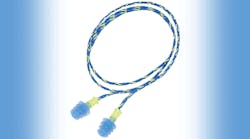Custom earplugs are made of various materials that fill the ear canal. Some are made using an impression material, which then is manufactured into the earplug and others instantly are created with the impression material curing into the earplug itself. Custom earplugs can be comfortable and might motivate workers to use them. However, even custom earplugs must be created and worn so that an acoustic seal is maintained within the ear canal.
Corded and uncorded
Detectable models
Cooler in hot/humid environments
Can provide highest levels of attenuation
Multiple sizes available to fit different ear canals
dependent upon good fit
Hygiene issues in dirty environments
Corded and uncorded
Detectable models
Cooler in hot/humid environments
Multiple sizes and shapes available to fit different ear canals Variety of materials with different characteristics
Slightly more expensive
than single use
Must be cleaned
No roll
Slightly more expensive
Active sound management
Can attach to radios and communication headsets
Variability in attenuation
Variable extended-life benefit
Variable quality
Readily available around
neck when not in use
Some noise transmission through band
Occlusion effect
HPD
Situational awareness
Impulse noise management
Possible solution for hearing impaired workers
Maintenance (batteries)
Costs $50 - $200 per unit
HPD
Lower attenuation ideal for moderate noise environments
Ideal for hearing-impaired workers
Available in earplugs or earmuffs
Slightly higher cost
HPD
awareness in quiet environments
Protection from impulse noise and high noise levels
Control unit as additional PPE to wear
Appropriate for specific applications or environments
HPD
Increased situational awareness
Can integrate active hearing protection, ANR, fit testing, PSEM
Connect with radios
Compatible with other PPE
Control unit as additional PPE to wear
Appropriate for specific applications or environments (eg. intrinsically safe)
Attenuation
Flat attenuation – Some earplugs have filters that allow less attenuation or allow some frequencies to have lower attenuation. These earplugs help to balance the need to decrease the noise level but maintain the ability to hear. This type of hearing protection is helpful for employees with existing hearing loss and for any employee who is exposed to relatively low levels of hazardous noise (usually up to about 95 dB).
Certain processes in the food industry and paper and pulp industry require that all personal protective devices have some metal component that is detectable. A few disposable and multi-use earplugs have this added feature.
Low attenuation – Earplugs don't always need to offer lots of attenuation. Many hazardous noise environments require only a slight amount of attenuation to protect the worker and over-protection might create other safety issues.
Electronic – Earplugs can provide amplification as well as attenuation. These types of earplugs are designed to allow sounds that are very quiet to be amplified and also to provide protection when sounds reach a hazardous level.
Corded – Essentially all earplugs can be corded or uncorded. The nature of the work, the work environment and personal preference can be factors in determining the use of cords.
An "appropriate variety" of earplug options depends on the worker population, the environment, the tasks and the noise level. This article has discussed only earplugs; other options to meet the hearing protection needs of workers include earmuffs, banded hearing protection and intelligent hearing protectors. The most important factor is that hearing protection must meet the needs of the noise-exposed worker.
Theresa Y. Schulz, Ph.D., (Lt. Col., retired, U.S. Air Force), is the hearing conservation manager for Honeywell Safety Products, a leading global provider of passive and intelligent hearing protection solutions. She has a B.S. in communication disorders, an M.A. in audiology in from the University of Texas at Austin and a Ph.D. in hearing science from the Ohio State University. She has been a member of the National Hearing Conservation Association (NHCA) for nearly 30 years and has served as its president. She is the president of the NHCA Foundation, and past chair of the Council for Accreditation in Occupational Hearing Conservation (CAOHC), a certified member of the American Speech-Language-Hearing Association (ASHA), a fellow in the American Academy of Audiology (AAA) and a member of the Air Force Audiology Association (AFAA). Contact Schulz by email at [email protected]. Learn more about Howard Leight at http://www.howardleight.com.
